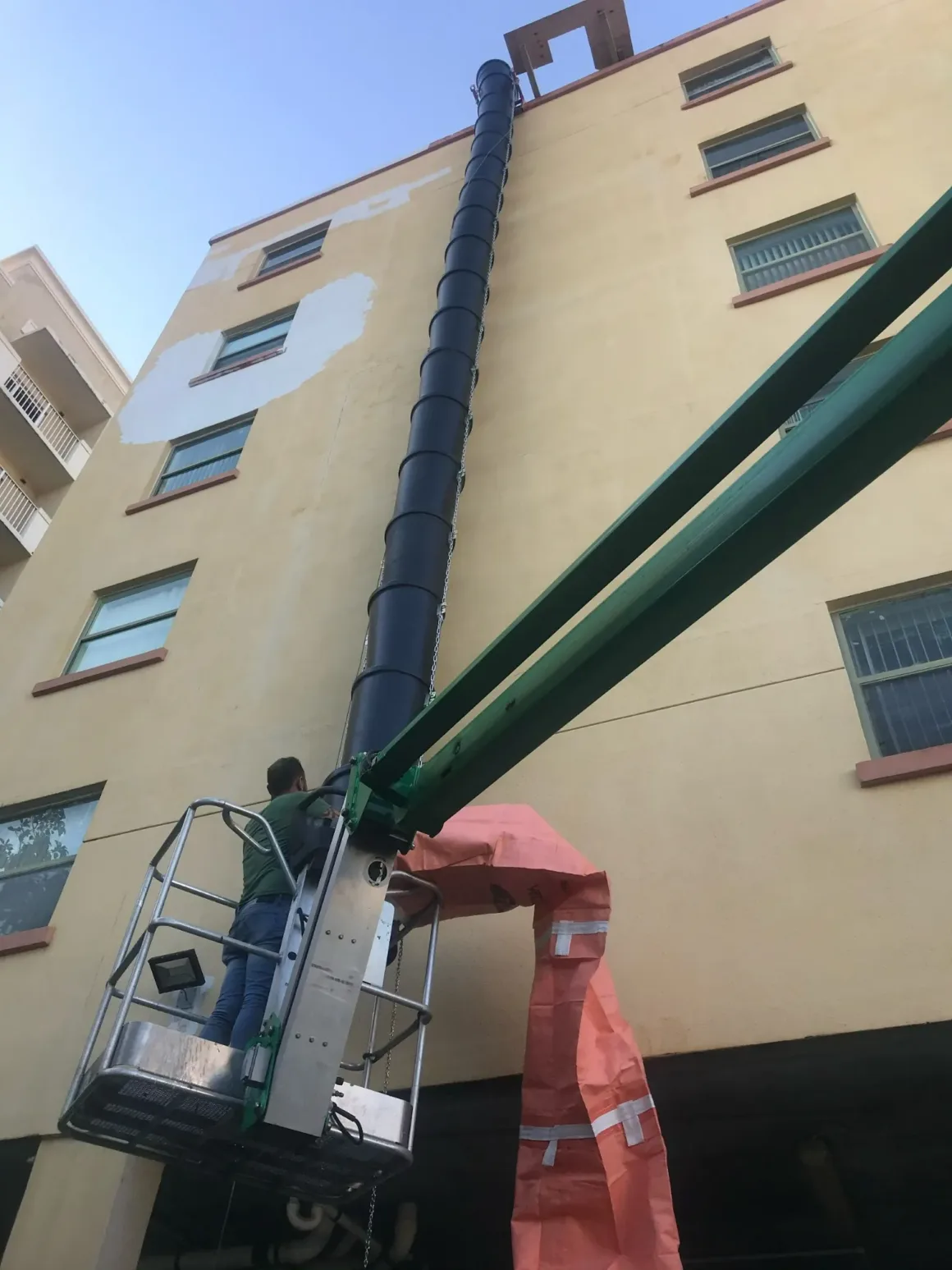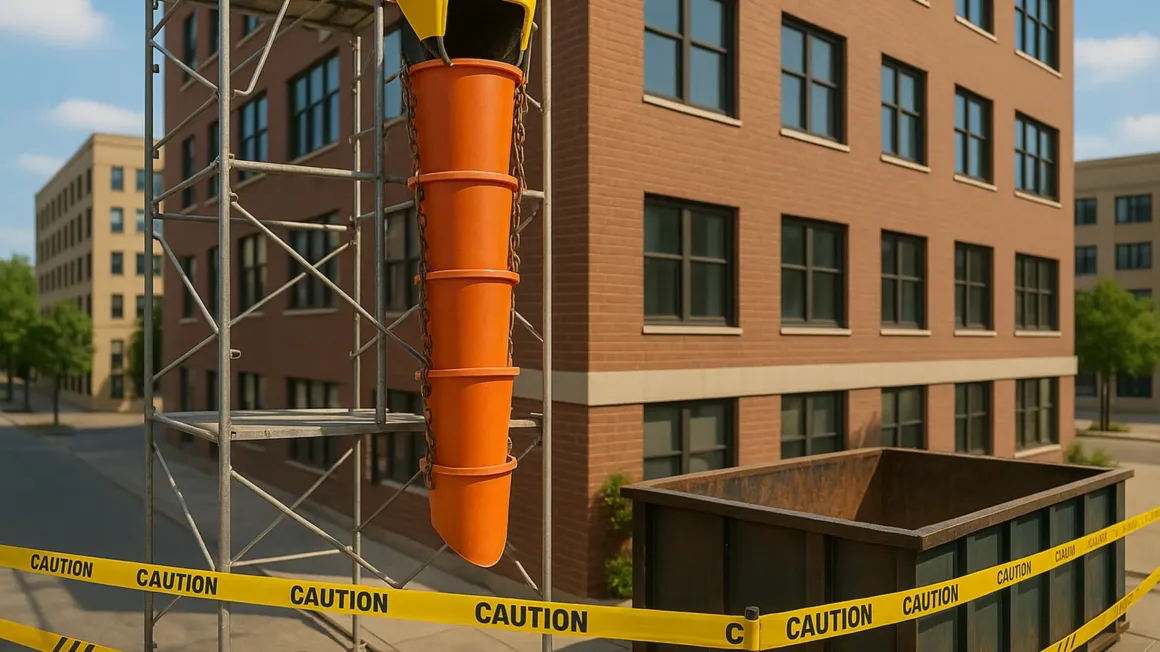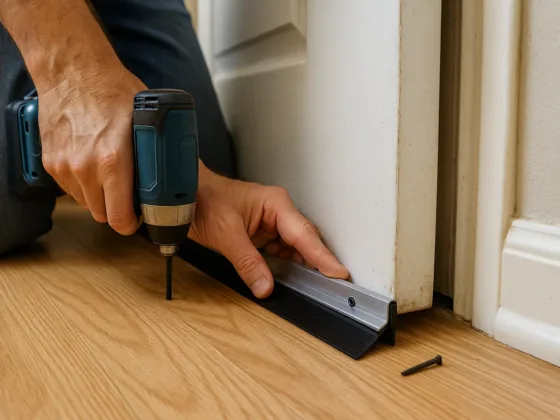Table of Contents Show
Last updated: October 5, 2025
By: Ricky McLain, P.E., S.E.
Reviewed by: Abby Ferri, CSP, ARM
Quick take: Plastic debris chutes move demo and roofing waste from upper floors to the dumpster fast—less lifting, less dust, fewer struck-by near-misses. This guide shows how to pick the right diameter, install and operate step-by-step, stay compliant with OSHA and local codes, and keep uptime high. Want a real-world example? See heavy-duty plastic debris chutes for construction projects.
Why plastic debris chutes matter (and when they’re required)

Debris chutes keep vertical pathways clear, reduce manual handling, and improve productivity across trades. See how renovation waste builds up quickly and why early waste planning prevents schedule drag.
Safety & compliance highlights (U.S.):
- If debris is dropped more than 20 ft outside a building, an enclosed chute is required (OSHA 29 CFR 1926.252).
- Use closures for intermediate openings; keep them shut when not in use (1926.852).
- Provide guardrails (~42 in) at dumping points and control the discharge zone with barricades/signage.
Always verify local rules. Some cities (e.g., New York City Admin Code §3303.5.5) require rigid bracing and added inspections.
Plastic debris chutes vs. steel (choose by risk, height, and noise limits)
Related reading to visualize real jobsite conditions: a practical roof tear-off cleanup walkthrough.
| Factor | Heavy-Duty Plastic (HDPE) | Steel |
|---|---|---|
| Weight/handling | Light; fast to rig, fewer workers | Heavy; equipment often needed |
| Impact & abrasion | Thick HDPE resists cracking; quieter | Extremely strong; can dent; corrosion possible |
| Weather/corrosion | Impervious to rust; UV-stable grades available | Requires coatings; corrosion risk |
| Noise | Lower (better for urban sites) | Higher |
| Lifecycle cost | Low maintenance; modular | High durability; higher maintenance in mobile use |
| Best for | Roofing, general demo, high-rise housekeeping | Very heavy industrial or high-heat risks |
Which plastic debris chute diameter is right?
Typical options: 21″ (compact), 26″ (balanced), 33″ (maximum throughput).
- 21″: Light debris or tight scaffolds.
- 26″: Mid-rise projects with moderate volume.
- 33″: Bulky demolition debris, multi-story high volume.
Pair your diameter with the container you’ll stage below: start with these 10 tips for choosing the right dumpster rental.
Spec checklist (copy/paste for submittals)
- Material: HDPE, heavy-duty wall thickness for abrasion resistance
- Module length: 4–5 ft segments (stackable)
- Reinforcement: Chain/cable/metal rings at collars; load-rated connectors
- Hoppers/closures: Self-closing recommended at intermediate floors
- Mounting: Manufacturer-approved brackets/anchors to scaffold or structural frame
- Accessories: Top hopper, intermediate hoppers, winch, bottom diverter to container
- Landing zone: Barricaded with signage; toeboards/bumper stops at discharge
Plastic debris chute installation: step by step
Before rigging, review interior demolition steps and how to avoid scaffolding accidents.
- Pre-task plan (JHA): Identify drop heights, container location, pedestrian paths, utilities, and exclusion zones.
- Rigging point: Select a structural tie-in or scaffold tie meeting manufacturer loads; verify anchor ratings.
- Top hopper first: Secure top frame; check vertical alignment to avoid tight bends.
- Stack segments: Connect from the top down; lock collars/chains each time and confirm interlocks.
- Intermediate floors: Install self-closing hoppers; add guardrails (~42″) and solid infill around floor openings.
- Discharge control: Install gate/deflector; barricade the landing area; assign a competent person to control the gate and trucks.
- Container alignment: Position dumpster/bags precisely under discharge; use toeboards/bumper stops.
- Commissioning: Test with small loads; verify sway, connections, signage, and radio/hand-signal comms.
Required use case: If dropping debris >20 ft, use an enclosed chute or fully enclose and restrict the drop area.
Operating rules & housekeeping
Stay proactive on site safety: see home construction hazards and how to avoid them.
- Debris sizing: Oversized pieces clog chutes; break down bulky materials before loading.
- One-at-a-time hoppers: Keep other openings closed while one is active.
- Struck-by prevention: Maintain exclusion zones and post signage; use spotters during loading.
- After hours: Close/barricade the discharge area and secure hoppers.
Add a recycling/ESG angle to reduce costs: the environmental impact of construction waste.
Maintenance schedule (maximize service life, minimize downtime)
- Daily: Inspect collars, chains/cables, gates, brackets; look for cracks/misalignment.
- Weekly: Wash internal surfaces to reduce dust/abrasion; lube hinges.
- After impacts: Replace damaged segments immediately; never operate with deformed connectors.
- Storage: Lay flat or hang straight; avoid heat warping.
Cost & ROI notes (for PM buy-in)
For budgeting and disposal planning, see our complete guide to home construction waste disposal.
- Labor savings: Faster vertical removal keeps elevators/stairs clear and reduces manual carries.
- Schedule protection: Less cleanup overlap with other trades shortens critical path.
- Risk reduction: Fewer struck-by and manual-handling exposures can reduce incident costs/insurance modifiers.
Real-world results & product validation (HOD Chutes)
Why HOD Chutes? Contractors report faster cleanup and fewer manual carries thanks to high-capacity, modular sections, heat-treated hardware, and a tapered, nestable design for quick rig/derig cycles. Key points and examples below.
Field outcomes (anecdotal but useful)
- Contractor testimonial: “Installed a HOD Chutes debris chute system on a mid-rise demo and saved my team about a week of work.” — General contractor review (outcomes vary by scope, height, crew size, and waste plan).
33-inch model highlights (specs that impact throughput)
- Inside diameter & taper: approx. 33″ top opening tapering near the bottom to smooth the flow of bulky demolition waste.
- Section sizing: approx. 4′ per segment with ~3′ usable drop; nestable for transport and storage.
- Hardware: heat-treated, proof-tested, galvanized chains and connectors for repeated lifts and weather exposure.
- System design: intermediate hoppers enable multi-floor loading; optional winch kits simplify controlled lowering.
Compliance & manufacturing quality
- OSHA alignment: Designed for use on sites following OSHA 29 CFR 1926.252/1926.852 debris-disposal and chute requirements (guardrails, closures, competent-person controls still apply).
- Manufacturer note: HOD Chutes indicates production by an ISO-certified facility (verify specific standard and certificate number during submittals).
Independent support for chute benefits
Enclosed debris chutes reduce manual material handling, speed cleanup, and improve housekeeping/inspection readiness—key drivers of schedule reliability and fewer struck-by exposures.
Beyond OSHA, see NIOSH’s construction resources on struck-by prevention and CPWR guidance on falling-object controls for planning, toeboards/screens, debris nets, and barricading best practices; for local-code context, NYC Building Code §3303.5.5 (Chutes) details rigid support/bracing requirements; to vet vendor QA claims, review ISO 9001:2015 (quality-management systems); and for broader performance impacts, scan peer-reviewed research on construction waste management and site efficiency (e.g., journals like Waste Management & Research and Sustainability).
How this solves common pain points
- Bottlenecks on upper floors: Large-diameter 33″ sections accept bulkier debris with fewer jams.
- Slow mobilization: Tapered, nestable segments shrink transport volume and accelerate install/strike.
- Hardware fatigue: Heat-treated, proof-tested connectors are designed for repeated rigging cycles.
Evidence snapshot
- Mid-rise interior demo, 8 stories (GC case note): Crew reported fewer stoppages at floor hoppers after switching to a 33″ tapered chute with intermediate loading points; superintendent noted smoother housekeeping checks and faster end-of-shift cleanup.
- Roof tear-off, occupied building (roofer case note): Larger hopper opening and nestable sections reduced setup time at start of shift; quieter HDPE walls helped with neighbor noise expectations compared to steel.
- Historic rehab (CM case note): Controlled discharge into a container bay kept pedestrian routes clear; spotter + barricaded zone improved inspector sign-off on debris controls.
Frequently asked questions
Not always. But when dropping debris more than 20 ft outside a building, an enclosed chute is mandatory (OSHA 29 CFR 1926.252). Alternatives require fully enclosed drop areas and restricted access.
Use 33″ for high-volume bulky demo, 26″ for balanced throughput, 21″ for tight sites/light loads. Match to container capacity and floor-by-floor loading points.
Yes. OSHA requires a substantial gate at/near discharge and a competent employee to control operations (1926.852).
Consult your hauler’s list and local rules; prohibited items vary. For planning context during renovations, see why every home renovation needs a dumpster.










